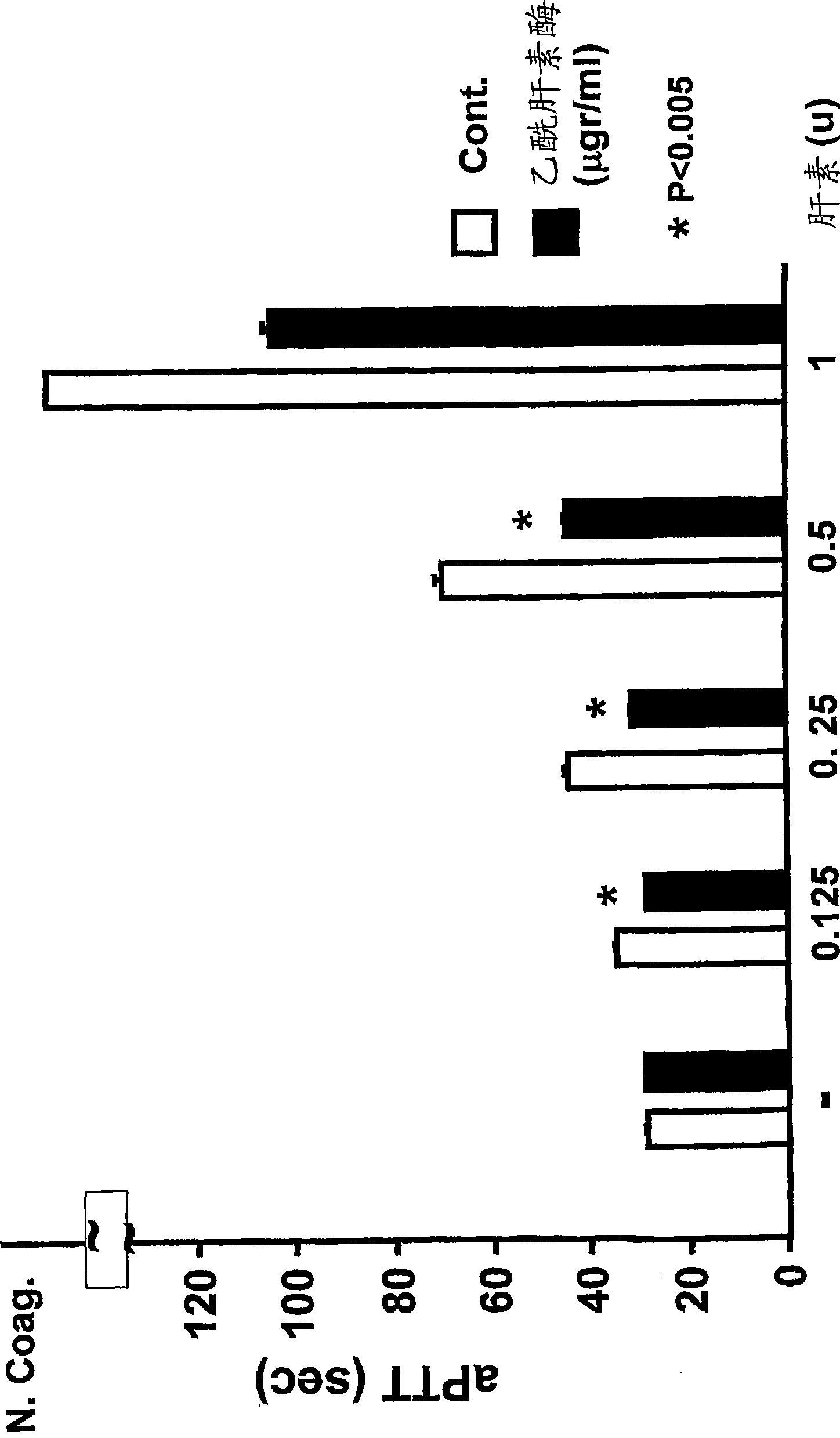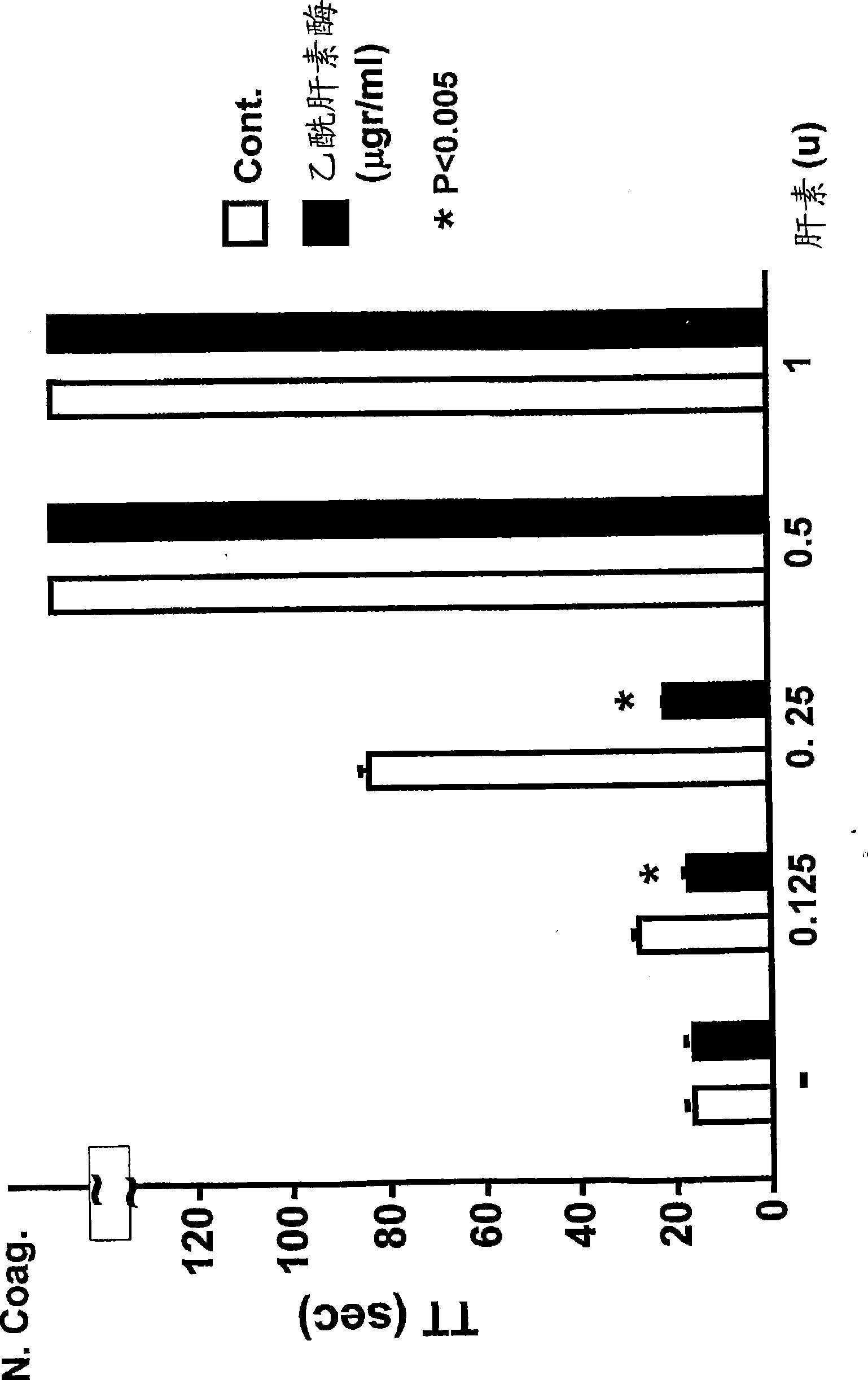Use of non-catalytic form of heparanase and peptides thereof for reversing the anti-coagulant effects of heparinoids
A technology of heparanase and anticoagulant activity, applied in medical preparations containing active ingredients, blood diseases, peptide/protein components, etc., can solve the problem of not being able to obtain a unified
- Summary
- Abstract
- Description
- Claims
- Application Information
AI Technical Summary
Problems solved by technology
Method used
Image
Examples
Embodiment 1
[0181] Heparanase zymogen has no direct effect on coagulation
[0182] To examine the possible role of heparanase in the coagulation process, the inventors performed various coagulation tests, including activated partial thromboplastin time (aPTT, which tests the intrinsic coagulation pathway), prothrombin time ( PT, which tests the extrinsic coagulation pathway), thrombin time (TT, which measures thrombin-mediated fibrinogenesis), and protein C and protein S (both are inhibitors of coagulation).
[0183] The effect of heparanase on platelet aggregation stimulated by various mediators (eg ADP, collagen, thrombin) was next tested. As shown in Table 1, all of these coagulation functions were unaffected by the presence of the proheparanase zymogen and they were all within the normal range.
[0184] Table 1. Heparanase zymogens that do not directly affect coagulation
[0185]
[0186] * Shown is a single representative experiment out of 2-4 experiments performed.
Embodiment 2
[0188] Proheparanase zymogen reverses heparin-induced shortening of aPTT and TT responses
[0189] The extent of the blood coagulation response requires a balance of anticoagulant components and associated coagulation inhibitors in the microenvironment of the endothelium represented by cell surface HSPGs. Heparanase released by platelets upon activation acts as a physiological coagulant. Therefore, the inventors tested the heparanase-mediated down-regulation of heparanase on coagulation activity under conditions that do not support its enzymatic activity (e.g. using inactive heparanase zymogen at neutral pH). effect. Two coagulation assays were affected by heparinoids: the activated partial thromboplastin time (aPTT), which measures the intrinsic coagulation pathway, and the thrombin time, which measures the thrombin-mediated conversion of fibrinogen to fibrin ( TT). Such as figure 1 As shown, in both cases, heparin forms a ternary complex with the natural thrombin inhibit...
Embodiment 3
[0191] Heparanase zymogen reverses the anticoagulant effect of heparin by restoring factor Xa activity in vitro and in the plasma of human patients treated with LMWH
[0192] Such as figure 1 Another mode of ATIII activity was shown to be the formation of inhibitory complexes with activated coagulation factor X (Xa). This factor will associate Factor Va with prothrombin, thereby forming a prothrombinase complex on the endothelium, leading to thrombin generation and subsequent clot formation. Unfractionated heparin or low molecular weight heparan (LMWH) binds to AT and induces a conformational change leading to the binding of factor Xa and inhibition of factor Xa activity.
[0193] In recent years, LMWH has been widely used as an anticoagulant due to its outstanding anticoagulant activity and improved pharmacokinetics compared with unfractionated heparin. However, antidotes that can inhibit these clinically highly abundant anticoagulants are not yet available in terms of urge...
PUM
| Property | Measurement | Unit |
|---|---|---|
| molecular weight | aaaaa | aaaaa |
| molecular weight | aaaaa | aaaaa |
Abstract
Description
Claims
Application Information
 Login to View More
Login to View More - R&D
- Intellectual Property
- Life Sciences
- Materials
- Tech Scout
- Unparalleled Data Quality
- Higher Quality Content
- 60% Fewer Hallucinations
Browse by: Latest US Patents, China's latest patents, Technical Efficacy Thesaurus, Application Domain, Technology Topic, Popular Technical Reports.
© 2025 PatSnap. All rights reserved.Legal|Privacy policy|Modern Slavery Act Transparency Statement|Sitemap|About US| Contact US: help@patsnap.com



